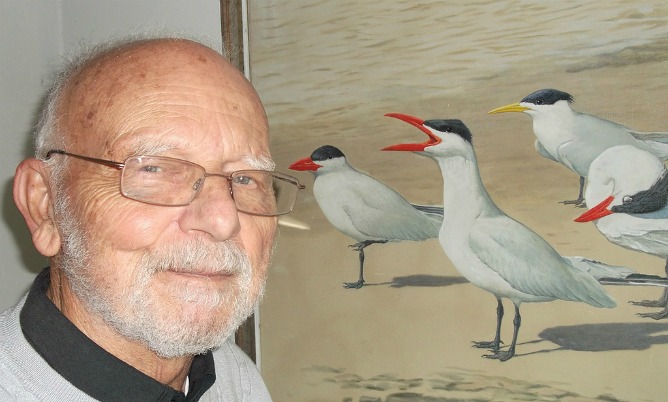Road kill, for most people, is something you try not to look at too closely and leave behind. But for Walter Ferguson these misfortunate animals could be a prized treasure.
Ferguson, one of the world’s preeminent wildlife artists, would never wish for a little creature to be maimed. However, if such an occurrence does happen, he sees the potential of bringing the animal back to life in his work.
“Art can contribute to the awareness of animals,” Ferguson tells ISRAEL21c. “If you want to preserve an animal you need to show it.”
Nearly all of the animal kingdom can be found in Ferguson’s work. His home in Beit Yanai — overlooking the Mediterranean coastline — is a private jungle with pictures of animals, birds and rodents lining the walls.
Spread the Word
• Email this article to friends or colleagues
• Share this article on Facebook or Twitter
• Write about and link to this article on your blog
• Local relevancy? Send this article to your local press
Most Israelis have never heard his name. But in international animal art circles, the 81-year-old artist is well known. He has drawn and illustrated works for countless books and magazines, as well as full-sized pieces that have been shown in galleries and at art fairs across the globe.
Ferguson recently exhibited his works at the Jerusalem Bird Observatory.
“You won’t find animal art in an Israeli museum,” Ferguson says. “There is no tradition for wildlife art in Israel.”
He’s on a personal mission to change that.
Teeth and feathers
Ferguson starts his day at the drawing board or on the computer looking at teeth.
A staff artist for the department of zoology at Tel Aviv University for nearly 30 years, Ferguson has also authored more than a dozen scientific papers on zoology and paleo-anthropology.
Now writing a book on the earliest known human ancestor, he reads scientific papers, makes sketches and compares the cast-iron teeth and skulls that he keeps in boxes in his office, drawing room and living room.
His wife, Ruth, has no qualms about these boxed fossils. After all, when Ferguson started his animal art career, he used to keep road kill in his freezer.
“Snakes, birds, small mammals, shrews, gerbils … ” Ferguson rattles off a list as if it were the most normal thing to do.
He was born in New York City in 1930. When he was 13 years old, a classmate asked for his help in learning about birds, and that’s what really piqued his interest in animals.
“We went to a park and he showed me all these birds I thought only lived in a zoo,” he says. “Before that I drew cartoons.”
Ferguson trained at Yale School of Fine Arts and at the Pratt Institute. In 1965, he immigrated to Israel and briefly taught art at the Bezalel Academy of Arts before accepting a position at Tel Aviv University.
From the cave to the museum
Artists have always created paintings of animals. Stone Age people decorated their caves with images of the animals they hunted, ancient Egyptians and Indians painted their gods with animal heads, 18th century artists celebrated the majesty of animals in their natural habitats and Victorian artists painted pictures of their pets.
[scrollGallery id=16 useCaptions=true]
Today, animal art is popular in North America, Europe, Australia and South America. In Israel, however, there are no displays dedicated to the art form.
“You might find some art that includes an animal but it’ll be abstract or expressionistic. I paint in a realistic, classical style, and until recently this style was frowned upon in Israel,” Ferguson says.
“In the art world, a lot of museums distinguish between illustration and fine art,” explains Ferguson, who classifies his work as both. “And yet Michelangelo was an illustrator. So the line between fine art and illustration is very fine. If it’s in a book, then it’s an illustration. If it’s on a wall, then it is fine art.”
Ferguson hopes his work will help Israeli art lovers open up to this genre of drawing.
Paradise found
The paintings jostling for space on the walls of Ferguson’s home are highly realistic: a squirrel that looks like it’s about to pounce, birds that seem to be eyeing the newcomer from their perches.
“Art is a language,” Ferguson says. “I hope people will get the feeling that I got — that this is paradise found.”
He says he studies the animals, their nuances, shape and color before drawing them. The grandfather of eight doesn’t keep track of how many drawings he’s done, but it’s well over 200.
In his home studio, a filing cabinet packed with sketches and newspaper clippings of all sorts of rodents, reptiles, animals and birds stands along one wall. Beside it is a file of more than 10,000 animal slides.
“There are thousands of animals I’d still like to draw,” says Ferguson, noting a painting can take anywhere from one day to six months to complete.
Those who know his work credit Ferguson for his flexibility, whether painting wildlife, portraits or landscapes. He has written and illustrated seven books – including The Mammals of Israel — and has illustrated 26 books and many articles. LIFE magazine commissioned him to illustrate endangered species while the American Museum of Natural History asked him to paint extinct animals.
Ferguson says his books, like his art, are meant to “increase awareness and help protect the mammals of the country for future generations.”













